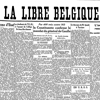National Content: Belgium
On this Tuesday, the trial of the biggest war criminals has just begun in Nuremberg
| Source | "La Libre Belgique", n°324, the 20th of November 1945, first page |
| Event referred to | 20th november 1945 : Beginning of Nuremberg trial |
| Technological characteristics | Type of file: Image Extension : pdf Characteristics Dimension of the file: 1892 Ko Availability proposed: pdf document with zoom options |
| Description of the source | Kind of source: Newspaper article Origin of the source: Archives of the University of Liège (Belgium) Language: French Copyright issues: reproduction and pedagogical exploitation authorized in the framework of the MHM project |
| Contextualisation of the source | « La Libre Belgique » is an important French-speaking newspaper. Started in 1884 under the title «Le Patriote», it become «La Libre Belgique» just after World War II. This daily paper of Catholic conservative trend is edited in Brussels. It sets itself against the influence of the syndicates in politics and it defends a very liberal economic policy. It is especially read in the large urban areas as well as in the small rural townships, by all social classes. In 1967, 170.000 copies were daily edited (J. GOL, Le monde de la presse en Belgique, édition du Centre de Recherche et d’Information socio-politiques – CRISP- 1970) |
| Interpretation of the source | The news concerning the trial appear at the bottom of the page, with some photographs of the 9 defendants (Karl Doenitz, Julius Streicher, Alfred Jodl, Franz Von Papen, Hermann Goering, Alfred Rosenberg, Arthur Seyss Inquart, Joachim von Ribbentrop, Wilhelm Keitel). These portraits have been shot when the Allies captured them. The biggest portrait is the one of Hermann Goering, who has most impressed the journalists. The newspaper presents some defendants: it reports that Von Papen will be defended by his son. The journalist also states : “he is sure that his father will be released”. This fact shows the trust of some defendants facing their trial. Afterwards the journalist speaks about Rudolph Hess who appears as “amnesiac”. He recalls a movie presented in the courtroom, showing the life in the Auschwitz camp “at the time of its magnificence”. He stresses on the attitude of Rudolph Hess who declares: “Yes of course, I was probably there, but I don’t remember anything”. The journalist underlines the paradoxical attitude of Rudolph Hess, quoting several attempts made to arouse his memory. The journalist doesn’t believe in the amnesia thesis. He puts the question: “Is Rudolph Hess a malingerer ?” Finally, relaying the information of the “News Chronicle” and of the “Daily Mail”, the journalist recalls the arrest of Ms. Goering, specifying that she is isolated without any contact with her husband. The tendency of the newspaper is to be mostly objective: it underlines the facts, it explains the trial development and it puts some questions which will probably find answers later. However the journalist seems doubtful facing the attitude of some defendants ( Rudolph Hess in particular), and he waits for the next events. |
| Original Contents | « Une présentation de films tournés au temps de sa « splendeur » ne provoqua guère de réaction sur lui. Il se borna à déclarer : « Oui, évidemment, je dois avoir été là, mais je ne me souviens de rien ». D’autres procédés ont alors été employés : on lui demanda de dessiner une croix. Il s’exécuta. On lui demanda de la transformer en croix gammée. Il déclara qu’il ignorait cet emblème. L’examinateur lui indiqua comment procéder. Hess copia. On lui demanda s’il savait ce que signifiait la croix gammée. Après quelques hésitations, Hess expliqua : « Oui, j’ai vu cela, je crois, sur des drapeaux ». Au cours d’une autre expérience, Hess aurait été confronté avec Goering, qui devait pour cette occasion prendre la place du juge d’instruction. Hess, introduit dans la pièce, ne manifesta aucune surprise. Est-il un simulateur ? C’est ce que douze experts choisis parmi les plus hautes sommités mondiales, sont en train d’essayer d’élucider ». |
| Original Contents (English Translation) | The presentation of movies filmed at the time of his “splendor” didn’t make him react. He only declared: “Yes, of course, I was probably there, but I don’t remember anything”. Other methods have been used : he was asked to draw a cross. He did it. He was asked to turn it into a swastika. He declared not to know this emblem. The examiner showed him how to do it. Hess copied. They asked him the signification of the swastika. After a short hesitation, Hess explained: “Yes, I have seen that, I think, on some flags”. During another experience, Hess has been confronted with Goering who took the place of the examining magistrate for this occasion. When he came into the room, Hess didn’t express any surprise. Is he a malingerer ? Twelve experts, selected among the highest personalities in the world, will try to answer this question. |
